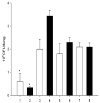Rifampicin reduces susceptibility to ofloxacin in rifampicin-resistant Mycobacterium tuberculosis through efflux
- PMID: 21512166
- PMCID: PMC3698754
- DOI: 10.1164/rccm.201011-1924OC
Rifampicin reduces susceptibility to ofloxacin in rifampicin-resistant Mycobacterium tuberculosis through efflux
Abstract
Rationale: Central dogma suggests that rifampicin resistance in Mycobacterium tuberculosis develops solely through rpoB gene mutations.
Objective: To determine whether rifampicin induces efflux pumps activation in rifampicin resistant M. tuberculosis strains thereby defining rifampicin resistance levels and reducing ofloxacin susceptibility.
Methods: Rifampicin and/or ofloxacin minimum inhibitory concentrations (MICs) were determined in rifampicin resistant strains by culture in BACTEC 12B medium. Verapamil and reserpine were included to determine their effect on rifampicin and ofloxacin susceptibility. RT-qPCR was applied to assess expression of efflux pump/transporter genes after rifampicin exposure. To determine whether verapamil could restore susceptibility to first-line drugs, BALB/c mice were infected with a MDR-TB strain and treated with first-line drugs with/without verapamil.
Measurements and main findings: Rifampicin MICs varied independently of rpoB mutation and genetic background. Addition reserpine and verapamil significantly restored rifampicin susceptibility (p = 0.0000). RT-qPCR demonstrated that rifampicin induced differential expression of efflux/transporter genes in MDR-TB isolates. Incubation of rifampicin mono-resistant strains in rifampicin (2 μg/ml) for 7 days induced ofloxacin resistance (MIC > 2 μg/ml) in strains with an rpoB531 mutation. Ofloxacin susceptibility was restored by exposure to efflux pump inhibitors. Studies in BALB/c mice showed that verapamil in combination with first-line drugs significantly reduced pulmonary CFUs after 1 and 2 months treatment (p < 0.05).
Conclusion: Exposure of rifampicin resistant M. tuberculosis strains to rifampicin can potentially compromise the efficacy of the second-line treatment regimens containing ofloxacin, thereby emphasising the need for rapid diagnostics to guide treatment. Efflux pump inhibitors have the potential to improve the efficacy of anti-tuberculosis drug treatment.
Figures



References
-
- Campbell EA, Korzheva N, Mustaev A, Murakami K, Nair S, Goldfarb A, Darst SA. Structural mechanism for rifampicin inhibition of bacterial RNA polymerase. Cell. 2001;104:901–912. - PubMed
-
- Telenti A, Imboden P, Marchesi F, Lowrie D, Cole S, Colston MJ, Matter L, Schopfer K, Bodmer T. Detection of rifampicin-resistance mutations in Mycobacterium tuberculosis. Lancet. 1993;341:647–650. - PubMed
-
- Bodmer T, Zurcher G, Imboden P, Telenti A. Mutation position and type of substitution in the beta-subunit of the RNA polymerase influence in-vitro activity of rifamycins in rifampicin-resistant Mycobacterium tuberculosis. J Antimicrob Chemother. 1995;35:345–348. - PubMed
Publication types
MeSH terms
Substances
Grants and funding
LinkOut - more resources
Full Text Sources
Other Literature Sources
Medical

